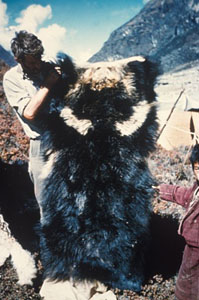
June 6, 2011

The Tibetan bear or Tibetan blue bear (Ursus arctos pruinosus) is a subspecies of the brown bear (Ursus arctos) found in the eastern Tibetan plateau. It is also known as the Himalayan blue bear, Himalayan snow bear, Tibetan brown bear, or the horse bear. In Tibetan it is known as Dom gyamuk. One of the rarest subspecies of bear in the world, the blue bear is rarely sighted in the wild. The blue bear is known in the west only through a small number of fur and bone samples. It was first classified in 1854.

The blue bear is notable for having been suggested as one possible inspiration for sightings associated with the legend of the Yeti. The World Book Encyclopedia 1960 expedition to search for evidence of the Yeti, led by Sir Edmund Hillary, returned with two scraps of fur that had been identified by locals as “Yeti fur” that were later scientifically identified as being portions of the pelt of a blue bear, according to the media. The story was a little more complex, having involved Hillary’s buddy, Desmond Doig buying the blue bear fur (shown above) earlier and setting up a situation where it would be presented later as a “Yeti skin.” Part of the mission of Hillary’s expedition was to spy on the Chinese government’s testing of rockets in Tibet. The Yeti search was a cover story, for Hillary was out to debunk the Abominable Snowmen from the start, apparently.
While it is unlikely that the blue bear generally occupies the high mountain peaks and snow fields where the Yeti is sometimes sighted, it is possible that the occasional specimen might be observed traveling through these regions during times of reduced food supply, or in search of a mate. However, the limited information available about the habits and range of the blue bear makes such speculation difficult to confirm.
The Gobi brown bear is sometimes classified as being of the same subspecies as the Tibetan blue bear; this is based on morphological similarities, and the belief that the desert-dwelling Gobi bear represents a relict population of the blue bear. However, the Gobi bear is sometimes classified as its own subspecies, and closely resembles other Asian brown bears.

The exact conservation status of the blue bear is unknown, due to limited information. However, in the United States trade in blue bear specimens or products is restricted by the Endangered Species Act. It is also listed in Appendix I of the Convention on International Trade in Endangered Species (CITES) as a protected species. It is threatened by the use of bear bile in traditional Chinese medicine and habitat encroachment.
Now comes word of an auction of one such “Yeti Skin,” i.e. blue bear skin. If there are several forms of Yetis, this is the one that appears to explain some reports of the largest variety. Rare indeed, it would be a prize catch for a cryptozoology museum, of course. Here is the announcement of the auction:
Grand Summer Auctions at Geneva’s Hotel des Ventes Presents a Variety of Lots
*GENEVA.-* Hôtel des Ventes‚ summer auctions will be held on Monday 20th
to Thursday 23rd June with a global estimate of 2,000,000-3,000,000
Swiss francs. The books department will open the sale with a specialised
session featuring the personal library of eminent Vaudois historian
Jean-René Bory. Tuesday’s sale will also be dedicated to pre-Colombian
Archaeology dating from the 1st millennium BC to the Spanish Conquest.
The distinguished Jewellery and Watches sale on Thursday will notably
feature an important 12 carat Ceylon sapphire (non-heated) and diamond
ring. A blue bear hide, long considered a Yeti skin, will no doubt form
one of the great curiosities and major attractions of the auction.Following a tradition established in 1978, Hôtel des Ventes will present
a variety of specialist antiques to tempt and seduce all collectors
during this one-week of auctions: Silver, Tribal and Primitive Art,
Leather Goods, Antique and Contemporary Furniture, Paintings,
Photographs and Works of Art. With the constant objective to democratize
auctions and make them more accessible for all, Hôtel des Ventes offers
over 500 quality lots this June at less than 300 Swiss francs…*On the Yeti’s trail ~ From the Himalayas to Geneva!*
On Wednesday 22nd June, Hôtel des Ventes will sell the back fur of an
extremely rare specimen known as the Tibetan blue bear Ursus arctos
pruinosus which many cryptozoologists and conservationists have
concluded is the most likely candidate in identifying the infamous Yeti.
Collected during a Himalayan expedition, this particular pelt was first
sold in 1978 by Christie’s London during a time when a lot of interest
surrounded the mystery of the yeti or abominable snowman. Various
sightings, hair samples and footprint recordings were being
investigated. The hype surrounding the sale of this seldom-seen bear
hide reached Switzerland and enticed a Swiss collector to participate in
claiming a piece of yeti history and the opportunity has now represented
itself.According to media accounts surrounding the 1978 sale, this particular
pelt adorned the throne of a religious chief in a monastery in the
northern region of Bhutan. Commonly known in this area as “Migou” (wild
man), each country in the Himalayan region has its own name for the Yeti
varying from “man-bear” to “snow-man.” Cryptid or not, this creature had
obviously infiltrated the Sherpa culture. In 1954, the English explorer
John Angelo Jackson photographed symbolic paintings of the Yeti at the
Tengboche monastery in the Khumbu region of Nepal.Throughout most of the 20th century, interest surrounding the existence
of the Yeti steadily increased. Having adopted the more dramatic and
westernised name Abominable Snowman in the 1920s, popular culture soon
caught on to this infectious curiosity. Even the beloved cartoon
character Tintin encountered the Yeti in the 1960‚s adventure comic book
Tintin in Tibet after author Hergé became intrigued with the Sherpa
culture and Tibetan Buddhism.During his successful expedition along side the Sherpa Tenzing Norgay in
1953 to reach Mt Everest‚s summit, Sir Edmund Hillary was also drawn in
by the elusive Yeti. In 1960, he mounted an expedition to solve the
mystery behind this cryptid. A number of pelts and samples were
purchased and borrowed for laboratory testing. The results were
conclusive. All furs related to either the blue bear or other recognised
species inhabiting the Himalayan regions of Nepal, India and Tibet.There still remains a slight doubt surrounding the attribution of
footprints and the host animal of some unknown parasites discovered in
so-called Yeti feces. This said, even the Bhutanese King who was shown
the blue bear throne fur apparently declared that the great yeti and the
blue bear were one and the same animal.Could it be then, that this shy and rare blue bear has built itself a
reputation in certain Sherpa clan culture over the centuries to the
point of being one of the numerous demons believed to inhabit the
mountains? Or has western curiosity and sensationalism turned an
indigenous bear that often walks upright like a biped into a mythical
legendary creature? Whatever the judgment, the relationship of this
mythical creature to the Tibetan blue bear continues to fascinate us.*An auctioneering tradition since 1978*
Geneva’s Hôtel des Ventes grand summer sales will bring together over
2,500 lots of silver, antique and contemporary furniture, rugs and
carpets, photographs, paintings, primitive art, as well as Asian art,
jewellery and watches.For this autumn’s auctions, Bernard Piguet promises fine wines and haute
couture.Founded in 1978, Geneva’s Hôtel des Ventes was taken over by Bernard
Piguet who proceeded in building a team of 20 or so collaborators, 12 of
which are capable of valuing any object within the 300 to 300,000 francs
range. He also specialised in all matters concerning estate and inheritance.The auction house organises four sales a year each including 2,500 lots.
At the last auction back in the spring, Hôtel des Ventes managed to
achieve a number of record prices, notably for a Chinese rhinoceros horn
libation cup which sold for 365,000 Swiss francs.*Public exhibition:* Friday 17th, Saturday 18th and Sunday 19th June
from 12 noon to 7pm non-stop.*Auction calendar:*
Monday 20th June at 7pm: Antiquarian and modern books including the
library of Jean-René BoryTuesday 21st June at 2pm: Primitive and pre-Columbian art
Tuesday 21st June at 7pm: Art Nouveau, Art Déco, Decorative arts and Silver
Wednesday 22nd June at 9.30am: Collectables and Asian art
Wednesday 22nd June at 2pm: Furniture, Rugs and Carpets
Wednesday 22nd June at 7pm: Paintings and contemporary art, photographs
Thursday 23rd June at 2pm: Designer bags and accessories, Jewellery and
WatchesThursday 23rd June at 7pm: Jewellery and watches
=========================================================
“Yeti skin” could be hottest item at Geneva’s affordable auction
GENEVA, SWITZERLAND ˆ The most affordable auction in Geneva, one with
some 500 items that are valued at under CHF300, features an unusual item
this year, a blue bearskin that was for a long time reputed to be that
of a fabled Yeti. The annual summer event at the Hôtel des Ventes in
Geneva is set for 20-23 June, with a preview open to the public Friday
to Sunday, 17-19 June.The pre-sale estimate for the auction is a total of CHF2 to 3 million,
but the mix is enormous this year, in terms of price but also the items
for auction. The Yeti skin may be the great curiosity item but fine
jewelry estimates start at CHF1,000 and run up to CHF80,000, including a
diamond and sapphire ring from Ceylon for an estimated CHF20-30,000 and
a black diamond put at CHF5,000. Chanel and Louis Vuitton vintage bags
will be on the block as well as pre-Colombian artefacts ranging from
CHF500 to 3,000.The Yeti skin, to be auctioned 22 June, is estimated to have a value of
CHF2,000-3,000. It was reportedly carried back from Tibet by Edmund
Hillary in 1959 and the skin has since been certified by the British
Museum as belonging to one of the region‚s blue bears, Ursus arctos
pruinosus, which some believe to have been the mysterious Yeti.
[CHF 2,000-3,000 = EUR 1,640-2,460 = US$ 2,380-3,570. – Thanks to news tip from Bruno.]
About Loren Coleman
Loren Coleman is one of the world’s leading cryptozoologists, some say “the” leading living cryptozoologist. Certainly, he is acknowledged as the current living American researcher and writer who has most popularized cryptozoology in the late 20th and early 21st centuries.
Starting his fieldwork and investigations in 1960, after traveling and trekking extensively in pursuit of cryptozoological mysteries, Coleman began writing to share his experiences in 1969. An honorary member of Ivan T. Sanderson’s Society for the Investigation of the Unexplained in the 1970s, Coleman has been bestowed with similar honorary memberships of the North Idaho College Cryptozoology Club in 1983, and in subsequent years, that of the British Columbia Scientific Cryptozoology Club, CryptoSafari International, and other international organizations. He was also a Life Member and Benefactor of the International Society of Cryptozoology (now-defunct).
Loren Coleman’s daily blog, as a member of the Cryptomundo Team, served as an ongoing avenue of communication for the ever-growing body of cryptozoo news from 2005 through 2013. He returned as an infrequent contributor beginning Halloween week of 2015.
Coleman is the founder in 2003, and current director of the International Cryptozoology Museum in Portland, Maine.
Filed under Abominable Snowman, Artifacts, Breaking News, Cryptotourism, CryptoZoo News, Museums, Pop Culture, Yeti